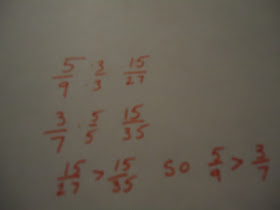CCSS.Math.Content.4.NF.A.2 Compare two fractions with different numerators and different denominators, e.g., by creating common denominators or numerators, or by comparing to a benchmark fraction such as 1/2. Recognize that comparisons are valid only when the two fractions refer to the same whole. Record the results of comparisons with symbols >, =, or <, and justify the conclusions, e.g., by using a visual fraction model.
I created this little fraction compare worksheet and chose fractions that I thought would elicit some of the different strategies suggested by the Common Core
The first one is 3/16 and 3/15
This questions is obviously written to illicit ideas about common numerators. We spend so much time on common denominators that sometimes common numerators get completely ignored!The majority of my students used unit fraction reasoning on this one. They reasoned that we had 3 pieces for each one and since fifteenths are larger than sixteenths, 3/15 would be larger than 3/16.
A few of my students tried drawing a model for this. Because these fractions are really close, it was hard to tell from their models which was larger because of the inherent margin of error with drawing models. Model drawing is an important first step for kids who are still working on developing conceptual understandings of fractions. It is not where I want to leave students at the end of grade 5, but it is an important first step!
Let's look at 5/9 and 3/7
The strategy I was trying to elicit with this one was comparing to the benchmark of 1/2. Here are the four strategies used by my group to compare these fractions |
| This student surprised me by using a common numerator strategy. It is actually very efficient for this problem. I didn't write the problem purposely to illicit this strategy but it works quite well. |
How about 5/6 and 7/8?
 |
| This student used reasoning about how far away from 1 these fractions are. They used what they know about unit fractions to help them with this comparison. |
The Last One
 |
| I chose this problem because it was really easy to create a common numerator for these numbers. That is what this student did and it was very effective and efficient! |
 |
| This student used a common denominator strategy to compare these two fractions. You can see that in this case it is much less efficient than finding a common numerator. |
This took an entire class period but I got such great ideas and strategies out of the students. I love days like this when kids have a lot of time to share strategies!
A GREAT resource if you want to really help your kids excel with fractions is this book A Focus on Fractions
What strategies do your students have for comparing fractions?







Thanks for linking up! Your post is extremely helpful! I am going to have to check out that book :)
ReplyDeleteJess
I {Heart} Recess
It is a great one! It really opened my eyes to what misconceptions kids have about fractions and why they have them.
Delete